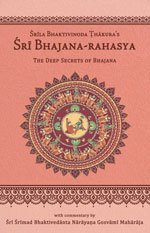Bhajana-Rahasya
by Srila Bhaktivinoda Thakura Mahasaya | 2010 | 123,965 words
The Bhajana-rahasya Text 29, English translation, including commentary (vritti). The Bhajana-rahasya is a compilation of verses describing the mercy of the eight pairs of names (Yugala-nama) of the Maha-mantra. This is text 29 belonging to the chapter “Dvitiya-yama-sadhana (Pratah-kaliya-bhajana)” representing the first six dandas of the morning: approximately 6.00 a.m.–8.30 a.m.
Text 29
Knowledge of the intrinsic natures of jīva-śakti and māyā-śakti is found in Śrīmad-Bhāgavatam (2.9.34):
ऋते’र्थं यत् प्रतीयेत न प्रतीयेत चात्मनि
तद् विद्याद् आत्मनो मायां यथाभासो यथा तमःṛte’rthaṃ yat pratīyeta na pratīyeta cātmani
tad vidyād ātmano māyāṃ yathābhāso yathā tamaḥThe Supreme Absolute Truth (parama-tattva, or svarūpa-tattva) is the only real truth. One should understand that which is seen to be separate from this truth, or not existing within it, to be the product of the Supreme Absolute Truth’s illusory energy (māyā). The following example demonstrates this. Parama-tattva can be compared to the sun, which is an object consisting of light. The sun is experienced in two other forms, namely its ref lection and darkness. Similarly, in regard to the Absolute Truth, ref lection pertains to the living entities (jīva-śakti) and darkness to the material world (māyā-śakti).
कृष्ण-शक्ति माया, कृष्ण हैते भेदाभेद
चिच्-छक्ति स्वरूपाश्रिता चिज्-ज्योति-सम्भेदkṛṣṇa-śakti māyā, kṛṣṇa haite bhedābheda
cic-chakti svarūpāśritā cij-jyoti-sambhedaजडाकारे माया-शक्ति छाया तमो-धर्म
प्रपञ्च प्रतीति याहे विनश्वर-कर्मjaḍākāre māyā-śakti chāyā tamo-dharma
prapañca pratīti yāhe vinaśvara-karma
Commentary: Bhajana-rahasya-vṛtti:
Although the jīva and māyā are both dependent on the Supreme Lord, a person does not experience them while he is directly experiencing Bhagavān. And while having experience of the jīva and māyā, he will not have experience of Bhagavān.
The intrinsic nature of the Supreme Absolute Truth was ascertained in the previous Text. The jīva and māyā are separate from the Supreme Absolute Truth (parama-tattva ). When a jīva realises parama-tattva, it is known as realised knowledge, vijñāna. This Text 29 elaborates upon māyā-tattva. Parama-tattva is the only real truth, and that which is experienced outside paramatattva and not within it is the product of the illusory energy of the Absolute Truth.
An example of this is seen in the sun, its reflection and darkness. A semblance of the sun is its ref lection on water or on other things at dawn. This semblance does not exist without the sun. Similarly, māyā is only perceived when the creative energ y of Śrī Bhagavān is manifest, and its existence is destroyed at the time of annihilation (mahā-pralaya). Without Bhagavān, māyā is not manifest. Where there is light, there can be no darkness, but darkness is also perceived through the eyes. In the same way, māyā cannot be perceived on its own without the help of the Supreme Lord. The transcendental world (cid-jagat) is herein compared with the rays of the sun, the Supreme Lord. Using the same analog y, the living entities are compared to the ref lection of Bhagavān, and the material world (māyā-jagat ) is compared with darkness. The material realm is very far from Bhagavān, the transcendental Truth (cit-tattva).
There are two kinds of relationship between parama-tattva and māyā-tattva. That which is experienced as separate from the Absolute Truth is māyā, and that which is very far from the Absolute Truth and in ignorance of it is also māyā. In this way, by carefully explaining the inherent nature of Himself, the living entity and māyā, Śrī Bhagavān explained sambandha-tattva to Lord Brahmā.
